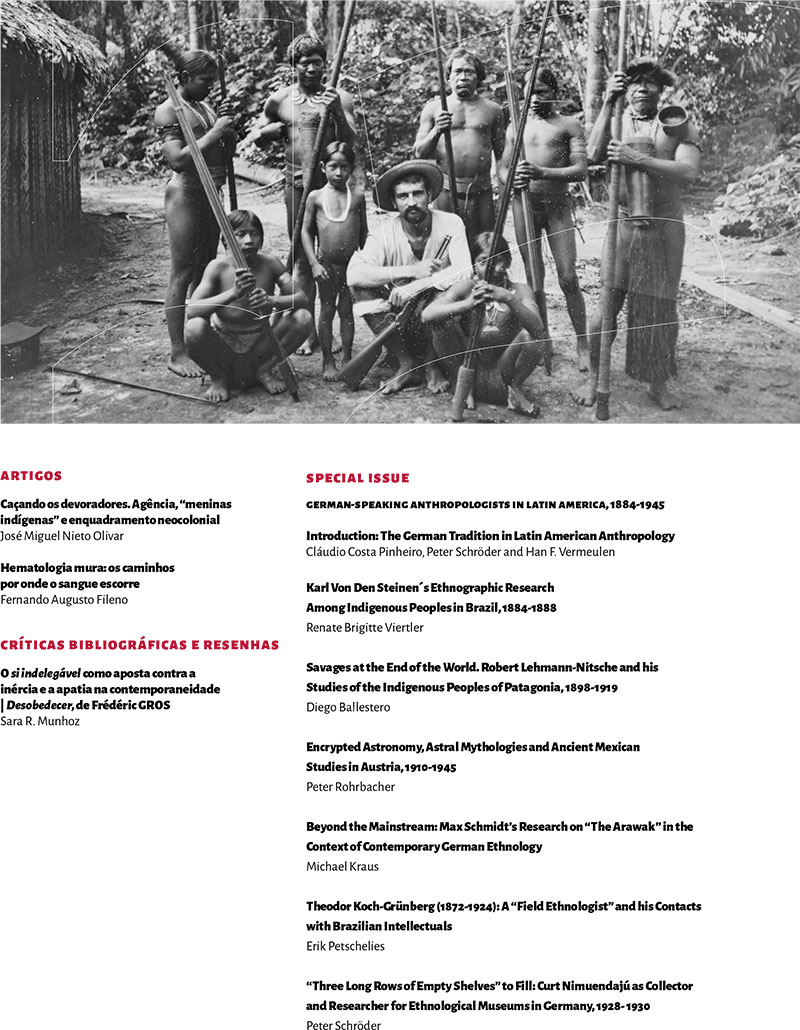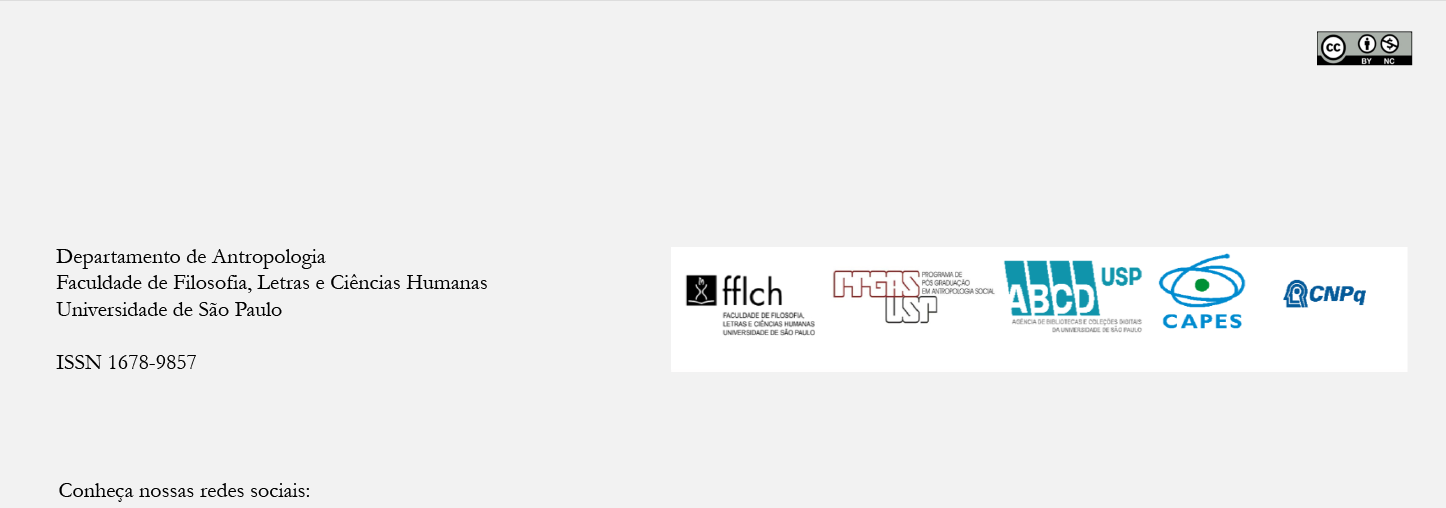“Three Long Rows of Empty Shelves” to Fill
Curt Nimuendajú as Collector and Researcher for Ethnological Museums in Germany, 1928-1930
DOI:
https://doi.org/10.11606/2179-0892.ra.2019.157040Palavras-chave:
Nimuendajú, German Ethnology, Ethnographic Collections, Ethnological Museums, Jê-speaking PeoplesResumo
In 1928-29 and 1930, the German-Brazilian anthropologist Curt Nimuendajú was contracted twice by German ethnological institutions (above all, museums) for organizing ethnographic collections and carrying out anthropological research among indigenous peoples; principally Jê-speaking peoples in various regions of today’s Maranhão and Tocantins states in Brazil. This is not only a lesser-known part of Nimuendajú’s biography, but also an example of a kind of academic cooperation difficult to imagine nowadays. The collections, partly destroyed during World War II, are still stored in the ethnological museums of Hamburg, Leipzig, and Dresden, along with a great number of mostly unpublished letters and other documents linked to them. The history of these expeditions offers an opportunity for reflections about the implicit theories involved in contemporary collecting, fieldwork methods, and the style of anthropology practiced. The research reveals influences from German ethnology on the academic environment in Brazil, which later became increasingly independent from this input.
Downloads
Referências
BECHER, Hans. 1955. “Die brasilianischen Sammlungen im Hamburgischen Museum für Völkerkunde und Vorgeschichte”. Anais do XXXI Congresso Internacional de Americanistas (1954), vol. I. São Paulo: 251-256.
BRUCK, Andreas. 1987. “Theorien und Theoriebilden in der Kulturanthropologie: Systematische Überlegungen zu einer unerfüllten Aufgabe.” In KÜNSTING, Sabine; BRUCK, Andreas; TSCHOHL, Peter (eds.), Mit Theorien arbeiten: Untersuchen in der Kulturanthropologie. Münster, LIT Verlag, pp. 11-59. (Anthropologische Schriften der Akademie ’85, 1).
CASTRO FARIA, Luís de. 1987. “Curt Nimuendajú”. In IBGE, Mapa etno-histórico de Curt Nimuendajú.2nd edition. Rio de Janeiro, Fundação Instituto Brasileiro de Geografia e Estatística/ Fundação Nacional Pró-Memória, pp. 13-18.
CLIFFORD, James. 1988. The Predicament of Culture: Twentieth-Century Ethnography, Literature, and Art. Cambridge, MA, Harvard University Press.
DAMM, Hans. 1966. “Fritz Krause: 1881-1963.” Jahrbuch des Museums für Völkerkunde zu Leipzig, Leipzig, vol. 22: 7-12.
DUNGS, Friedrich Günther. 1991. Die Feldforschung von Curt Unckel Nimuendajú und ihre theoretisch-methodischen Grundlagen. Bonn, Holos Verlag (Mundus Ethnologie, 43).
FISCHER, Manuela et al. (eds.). 2007. Adolf Bastian and His Universal Archive of Humanity: The Origins of German Anthropology. Hildesheim/New York, Georg Olms Verlag.
GEISENHAINER, Katja. 2002. “Rasse ist Schicksal”. Otto Reche (1879-1966) – ein Leben als Anthropologe und Völkerkundler. Leipzig, Evangelische Verlagsanstalt.
GRUPIONI, Luís Donisete Benzi. 1998. Coleções e expedições vigiadas: os etnólogos no Conselho de Fiscalização das Expedições Artísticas e Científicas no Brasil. São Paulo, Hucitec/Anpocs.
KÄSTNER, Klaus-Peter. 2009. Amazonien: Indianer der Regenwälder und Savannen. (exhibition catalogue) Dresden, Museum für Völkerkunde Dresden/Staatliche Ethnographische Sammlungen Sachsen.
KOPPERS, Wilhelm. 1924. Unter Feuerland-Indianern. Stuttgart, Verlag Strecker und Schröder.
KRAUS, Michael. 2004. Bildungsbürger im Urwald: Die deutsche ethnologische Amazonienforschung (1884-1929). Marburg, Förderverein «Völkerkunde in Marburg» e.V. (Curupira 19).
LOWIE, Robert H. 1920. Primitive Society. New York, Boni and Liveright.
LOWIE, Robert H.1924. Primitive Religion. New York, Boni and Liveright.
MENCHÉN, Georg. 1979. Nimuendajú – Bruder der Indianer. Leipzig, VEB Brockhaus Verlag.
MÜLLER, Klaus E. 1980. “Grundzüge des ethnologischen Historismus.” In SCHMIED-KOWARZIK, Wolfdietrich and STAGL, Justin (eds.), Grundfragen der Ethnologie: Beiträge zur gegenwärtigen Theorie-Diskussion. Berlin, Dietrich Reimer Verlag, pp. 193-231.
NIMUENDAJÚ, Curt. 1914. “Die Sagen von der Erschaffung und Vernichtung der Welt als Grundlagen der Religion der Apapocúva-Guaraní.” Zeitschrift für Ethnologie, Berlin, vol. 46: 284-403.
NIMUENDAJÚ, Curt. 1919/20. “Bruchstücke aus Religion und Überlieferung der Šipáia-Indianer: Beiträge zur Kenntnis der Indianerstämme des Xingú-Gebietes, Zentralbrasilien.” Anthropos, Mödling bei Wien, vol. 14-15, n. 4-6: 1002-1039.
NIMUENDAJÚ, Curt. 1929a. “Streifzüge in Amazonien.” Ethnologischer Anzeiger, Stuttgart, vol. 2, n. 2: 90-97.
NIMUENDAJÚ, Curt. 1929b. “Curt Nimuendajú im Gebiete der Gê-Völker im Innern Nordost-Brasiliens.” Anthropos, Mödling bei Wien, vol. 24 (3-4): 670-672.
NIMUENDAJÚ, Curt. 1939. The Apinayé. Washington, D.C., The Catholic University of America (Anthropological Series, 8).
NIMUENDAJÚ, Curt. 1946. The Eastern Timbira. Translated and edited by Robert H. Lowie. Berkeley and Los Angeles, University of California Publications in American Archaeology and Ethnology, 41.
NIMUENDAJÚ, Curt. 2000. Cartas do Sertão de Curt Nimuendajú para Carlos Estevão de Oliveira. Apresentação e notas de Thekla Hartmann (Coleção Coisas de Índios). Lisboa, Museu Nacional de Etnologia/ Assírio & Alvim.
NIMUENDAJÚ, Curt. 2004. In Pursuit of a Past Amazon: Archaeological Researches in the Brazilian Guyana and in the Amazon Region. By Curt Nimuendajú. A Posthumous Work Compiled and Translated by Stig Rydén and Per Stenborg. Göteborg, Världskulturmuseet (Etnologiska Studier, 45).
OLIVEIRA, João Pacheco de. 1999. “Fazendo etnologia com os caboclos do Quirino: Curt Nimuendaju e a história Ticuna.” In OLIVEIRA, J. P. de (ed.), Ensaios em antropologia histórica. Rio de Janeiro, Editora UFRJ, pp. 60-96.
PANE BARUJA, Salvador. 2014. Curt Nimuendajú – o alemão que virou índio no Brasil. Bochum: edition by the author. Available at: http://etnolinguistica.wdfiles.com/local--files/biblio%3Apane-baruja-2014-curt/pane_baruja_2014_curt.pdf, accessed August 31, 2018.
PENNY, H. Glenn. 2002. Objects of Culture: Ethnology and Ethnographic Museums in Imperial Germany. Chapel Hill, NC, University of North Carolina Press.
SCHRÖDER, Peter. 2011. “Curt Nimuendajú e os museus etnológicos na Alemanha.” Revista AntHropológicas, Recife, v. 22, n. 1: 148-167.
SCHRÖDER, Peter. 2013. “Nimuendajú em Berlim: sobre a história de uma coleção etnográfica no Museu Etnológico de Dahlem”. Paper presented at the IV Reunião Equatorial de Antropologia (REA)/do XIII Encontro de Antropólogos do Norte e Nordeste (ABANNE), Fortaleza, UFC, August 4-7.
SCHRÖDER, Peter. 2016. “Unckel, Curt.” In LANZINNER, Maximilian & KRAUS, Hans-Christof (eds.) (für die Historische Kommission bei der Bayerischen Akademie der Wissenschaften), Neue Deutsche Biographie, Bd. XXVI. Berlin, Duncker & Humblot, pp. 623-625.
SCHRÖDER, Peter. 2017. “Nimuendajú in Berlin: Zur Geschichte einer Sammlung im Ethnologischen Museum in Dahlem”. Paper presented at the German Anthropological Association (DGV) Conference 2017, Berlin, Freie Universität, October 4-7.
STAATLICHE MUSEEN ZU BERLIN – PREUSSISCHERKULTURBESITZ. ETHNOLOGISCHES MUSEUM (org.). 2002. Deutsche am Amazonas – Forscher oder Abenteurer? Expeditionen in Brasilien 1800 – 1914. (Veröffentlichungen des Ethnologischen Museums Berlin, Neue Folge, 71 / Fachreferat Amerikanische Ethnologie, IX) Berlin, Münster, LIT Verlag/SMPK.
STAATLICHES MUSEUM FÜR VÖLKERKUNDE DRESDEN. 1983. Indianer Brasiliens: Ausstellung des Staatlichen Museums für Völkerkunde Dresden zum 100. Geburtstag des Jenenser Indianerforschers Curt Unckel-Nimuendajú. Dresden, Staatliches Museum für Völkerkunde.
STOCKING, George W., Jr. (ed.). 1996. Volksgeist as Method and Ethics: Essays on Boasian Ethnography and the German Anthropological Tradition. Madison, WI, University of Wisconsin Press.
WELPER, Elena Monteiro. 2002. Curt Unckel Nimuendajú: um capítulo alemão na tradição etnográfica brasileira. Rio de Janeiro, master thesis, PPGAS/MN/UFRJ.2016 “Da vida heróica ao diário erótico: sobre as mortes de Curt Nimuendajú.” Mana, Rio de Janeiro, vol. 22, n. 2: 551-586.
WOLFRADT, Uwe. 2011. Ethnologie und Psychologie. Die Leipziger Schule der Völkerpsychologie. Berlin, Dietrich Reimer Verlag.
Downloads
Publicado
Edição
Seção
Licença
Copyright (c) 2020 Revista de Antropologia

Este trabalho está licenciado sob uma licença Creative Commons Attribution 4.0 International License.
Autores que publicam na Revista de Antropologia concordam com os seguintes termos:
a) Autores mantém os direitos autorais e concedem à revista o direito de primeira publicação, com o trabalho simultaneamente licenciado sob a Licença Creative Commons Attribution que permite o compartilhamento do trabalho com reconhecimento da autoria e publicação inicial nesta revista.
b) Autores têm autorização para assumir contratos adicionais separadamente, para distribuição não-exclusiva da versão do trabalho publicada nesta revista (ex.: publicar em repositório institucional ou como capítulo de livro), com reconhecimento de autoria e publicação inicial nesta revista.
c) Autores têm permissão e são estimulados a publicar e distribuir seu trabalho online (ex.: em repositórios institucionais ou na sua página pessoal) após o processo editorial, já que isso pode gerar alterações produtivas, bem como aumentar o impacto e a citação do trabalho publicado (Veja O Efeito do Acesso Livre).




